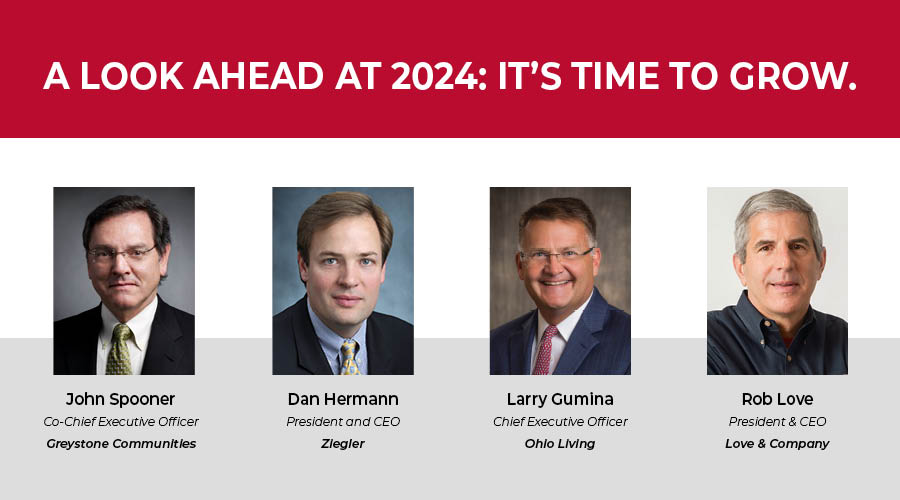The senior living market in this country has grown and thrived for more than 30 years, ever since members of the Greatest Generation first became interested in moving to senior living communities. This was especially true for healthcare-driven continuing care retirement communities that touted a continuum of healthcare services, an advantage that enjoyed such broad appeal that continued growth and prosperity seemed limitless.
Toward the end of the first decade of the new millennium, a series of demographic, financial, legislative and community health events occurred. Each event had a lasting impact on the senior living market. Here’s what happened:
- 2008—The bottom fell out of the real estate market, plunging the country into the Great Recession
- 2010—The first wave of baby boomers turned 65, ushering in the country’s largest-ever senior population
- 2012—The Affordable Care Act (ACA) was passed, which would soon prove to have a strong impact on senior eligibility for Medicaid
- 2020—The first wave of baby boomers turned 75 and actively entered the market for senior living
- 2020—The COVID-19 pandemic began, altering the conventional wisdom for how senior living could grow and prosper
A New Beginning
Even as the real estate economy cratered in 2008 and faltered until 2012, many not-for-profit senior living communities continued to flourish. But as time passed, a lot of smaller communities either fell by the wayside and closed or were acquired by for-profit, private sector organizations. In the past decade, the private sector has responded to the growth in the senior population with a highly competitive product that poses a great danger to traditional not-for-profits.
Two years into the Great Recession, the first baby boomers turned 65 and began to actively plan for their retirement. Unfortunately, many senior living communities failed to anticipate that this new generation of seniors had completely different sensibilities than their parents. Those communities began struggling, and the ones that are still in business will continue to do so unless they’re able to evolve.
As the 2010s moved along it became apparent that a new way of thinking was needed to keep the not-for-profit advantage intact. If communities failed to adapt, the private sector would most certainly step in to fill the void and keep growing to match the demographic growth.
What Needed to Happen
The course to survival and prosperity for not-for-profits required some significant changes in both thinking and action. The most successful communities discovered that their path included expanding an existing campus or adding satellite locations, rather than planning and building a new full-service campus. They also proactively retooled the Life Plan Community advantage, emphasizing empowerment and choice over available on-site healthcare. Many communities even scaled back their healthcare operations, turned to technology to enable care to be delivered by remote physicians and created satellite campuses that offer only basic healthcare services.
Moving Past COVID-19
In 2020, as the COVID-19 pandemic devastated nursing homes and assisted living communities, Life Plan Communities were desperate to find a way for their independent living residences to survive. Three new ways emerged to help not-for-profits grow without the financial risk of creating a whole new campus, each of which offers less risk and potentially great ROI. These include:
- Reaching into an underserved market, which can often be more cost effective than building new in a community’s existing market, especially when the existing market is highly saturated
- Exploring affordable housing, a growth area that is less familiar to traditional not-for-profit senior living organizations, and that may require affiliating with or acquiring an affordable housing developer
- Offering home and community-based services (HCBS), which often operate much like an expansion of an existing community, but with a separate department established to launch, manage and promote the program to the community
Bigger Is Stronger
Not-for-profit senior living of the future will be a business led by larger organizations, echoing the consolidation that’s been happening for decades in the healthcare market. It is now imperative to make the necessary structural changes that will keep the not-for-profit advantage intact. The growth that will come—and it’s already happening for many forward-thinking communities—will simply look and feel different from that of past models.
The new not-for-profit model will be a segmented business, operating a lot like Marriott, which transitions down from JW Marriott to Fairfield Inns. This is what the most successful systems are already doing to attract residents from a greater percentage of the senior population.
For senior living, multisite Life Plan Communities will be the high-end products, while strong affordable housing and home and community-based services round out the spectrum of offerings. This is how future billion-dollar systems will emerge.
What to Avoid
Just as there are new paths to ensuring growth in not-for-profit senior living, there are also pitfalls that can quickly sideline that growth. These include:
- Failing to maintain occupancy in the 90%s to be financially sound
- Failing to address and correct financial challenges
- Straying from the top position in a market while occupancy is high
- Ignoring the career paths of key staff members
- Having a board of directors that is not proactive
- Retaining an executive director who is not putting forth the effort
Not recognizing when there’s a challenge to growth—and not acting on it—almost guarantees that a community will be forced to affiliate with another not-for-profit.
Even worse, not affiliating with another not-for-profit at the right time can result in a community being acquired by a for-profit operator. Suddenly, all those volunteer hours put in by founders and board members become meaningless, and the private sector quickly acquires another competitive location.
An Unprecedented Time
The baby boomer generation is a one-off: We’ll never experience such a demographic surge of eligible seniors again. Senior living has weathered some tough times, but today’s market is ripe for those who understand how to structure a community and are willing to evolve and adapt to do so.





